
Flounders are a group of flatfish species. They are demersal fish, found at the bottom of oceans around the world; some species will also enter estuaries.

A flatfish is a member of the ray-finned demersal fish order Pleuronectiformes, also called the Heterosomata, sometimes classified as a suborder of Perciformes. In many species, both eyes lie on one side of the head, one or the other migrating through or around the head during development. Some species face their left sides upward, some face their right sides upward, and others face either side upward.

Halibut is the common name for three flatfish in the genera Hippoglossus and Reinhardtius from the family of right-eye flounders and, in some regions, and less commonly, other species of large flatfish.

Pleuronectidae, also known as righteye flounders, are a family of flounders. They are called "righteye flounders" because most species lie on the sea bottom on their left sides, with both eyes on their right sides. The Paralichthyidae are the opposite, with their eyes on the left side. A small number of species in Pleuronectidae can also have their eyes on the left side, notably the members of the genus Platichthys.
The Halibut Treaty was a 1923 Canadian–American agreement concerning fishing rights in the northern Pacific Ocean. The treaty established the International Pacific Halibut Commission (IPHC) as a mechanism for the joint management of the Pacific halibut which, at that time, was in severe decline. The commission originally had four members but now has six, which are selected from industry and related government agencies. Half the members are Canadian and half are from the United States. The treaty also had a provision for a closed season, so halibut could not be fished during the more dangerous winter months. The treaty has been revised numerous times, often based on recommendations from the IPHC and its team of scientific researchers.
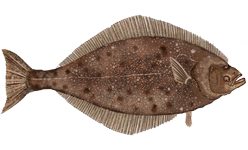
Hippoglossus stenolepis, the Pacific halibut, is a species of righteye flounder. This very large species of flatfish is native to the North Pacific and is fished by commercial fisheries, sport fishers, and subsistence fishers.

The Atlantic halibut is a flatfish of the family Pleuronectidae. They are demersal fish living on or near sand, gravel or clay bottoms at depths of between 50 and 2,000 m. The halibut is among the largest teleost (bony) fish in the world, and is a threatened species owing to a slow rate of growth and overfishing. Halibut are strong swimmers and are able to migrate long distances. Halibut size is not age-specific, but rather tends to follow a cycle related to halibut abundance.

The Greenland halibut or Greenland turbot belongs to the family Pleuronectidae, and is the only species of the genus Reinhardtius. It is a predatory fish that mostly ranges at depths between 500 and 1,000 m (1,600–3,300 ft), and is found in the cold northern Atlantic, northern Pacific, and Arctic Oceans.

The International Pacific Halibut Commission (IPHC) is an International Fisheries Organization, having Canada and the United States as its members, responsible for the management of stocks of Pacific halibut or Hippoglossus stenolepis within the Pacific waters of its member states. It was founded in 1923 by an international treaty. The original treaty has been revised three times. The 1979 amendment clarified the role of the IPHC in the management of the fishery through the North Pacific Halibut Act of 1982.
Eopsetta is a genus of righteye flounders native to the North Pacific Ocean.

The Pacific sand sole, also known as simply sand sole, is a flatfish species inhabiting the northeastern Pacific waters where it lives on sandy bottoms. The only species in the genus, Psettichthys, it ranges from the Bering Sea to Northern California.
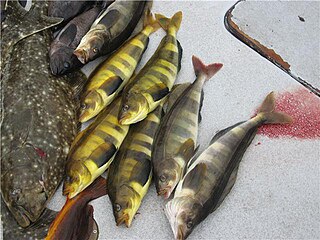
The Atka mackerel is a mackerel in the family Hexagrammidae. Atka mackerel are common in the northern Pacific ocean, and are one of only two members of the genus Pleurogrammus - the other being the Arabesque greenling. The Atka mackerel was named for Atka Island, the largest island of the Andreanof islands, a branch of the Aleutians.
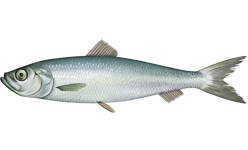
Clupea is genus of planktivorous bony fish belonging to the family Clupeidae, commonly known as herrings. They are found in the shallow, temperate waters of the North Pacific and the North Atlantic oceans, including the Baltic Sea. Two main species of Clupea are currently recognized: the Atlantic herring and the Pacific herring, which have each been divided into subspecies. Herrings are forage fish moving in vast schools, coming in spring to the shores of Europe and America, where they form important commercial fisheries.

The redbanded rockfish, also known as the bandit, barber pole, flag rockfish, Spanish flag, Hollywood, convict, and canary, is a species of marine ray-finned fish belonging to the subfamily Sebastinae, the rockfishes, part of the family Scorpaenidae. It is found in the northern Pacific Ocean.
the smooth alligatorfish, also known as the smooth poacher or the smooth sea-poacher,) is a fish in the family Agonidae. It was described by Albert Günther in 1860. It is a marine fish which dwells in temperate waters, and is known from the northern Pacific Ocean, including California, USA, and possibly Korea. It dwells at a depth range of 8–102 metres, usually around rocks. Males can reach a maximum total length of 15 centimetres.
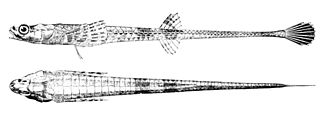
The alligatorfish, also known commonly as the Aleutian alligatorfish and the Atlantic alligatorfish, is a fish in the family Agonidae. It was described by Marcus Elieser Bloch in 1786. It is a marine, temperate water-dwelling fish which is known from the northwestern Atlantic Ocean, including western Greenland; Labrador, Canada; and Cape Cod, Massachusetts, USA. It dwells at a depth range of 0–695 metres, most often around 60–150 m, and inhabits sand and mud bottoms mostly on the lower continental shelf all year. It prefers a temperature range of -1.07 to 2.52 °C. Males can reach a maximum total length of 22 centimetres, but more commonly reach a TL of 14.2 cm.
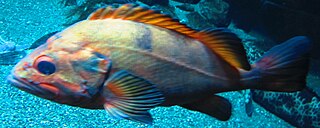
Sebastes melanostictus, the blackspotted rockfish, is a species of marine ray-finned fish belonging to the subfamily Sebastinae, the rockfishes, part of the family Scorpaenidae. It is found in the northern Pacific Ocean.

The headlight fish is a species of lanternfish in the family Myctophidae. It is also sometimes referred to as the headlight lanternfish, or even the lanternfish, though it is not the only species to be called this.















